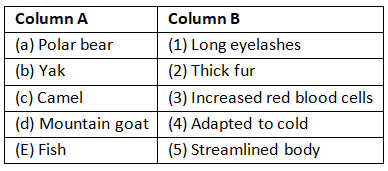Worksheet: Adaptations in Animals | Eureka Plus Class 5: Book Solutions, Notes & Worksheets PDF Download
| Table of contents |

|
| Multiple Choice Questions (MCQs) |

|
| Fill in the Blanks |

|
| True or False |

|
| Match the Following (In a Table) |

|
Multiple Choice Questions (MCQs)
Q1: Which animal is known for its thick layer of blubber?
(a) Yak
(b) Polar bear
(c) Cheetah
(d) Camel
Q2: What type of habitat do yaks primarily live in?
(a) Aquatic
(b) Desert
(c) Cold Mountainous regions
(d) Grasslands
Q3: Which adaptation helps camels survive in the desert?
(a) Long legs
(b) Thick fur
(c) Strong wings
(d) Sharp claws
Q4: Which of the following animals is nocturnal?
(a) Lion
(b) Owl
(c) Deer
(d) Cheetah
Q5: What is the primary reason for polar bears to have thick fur?
(a) To camouflage
(b) For insulation
(c) To attract mates
(d) To aid swimming
Fill in the Blanks
Q1: Animals in the polar regions have adaptations that help them survive in ________ conditions.
Q2: The ________ is a well-known animal that can go for days without water.
Q3: Animals like yaks and snow leopards are adapted to live in ________ regions.
Q4: Fish breathe using ________ to extract oxygen from water.
Q5: The ________ helps lions remain unnoticed until prey is near.
True or False
Q1: Camels have long eyelashes to protect their eyes from sand.
Q2: Polar bears are found in warm desert habitats.
Q3: Nocturnal animals are active during the day.
Q4: Fish are adapted to live only in water.
Q5: Yaks have fewer red blood cells than animals that live at lower altitudes.
Match the Following (In a Table)

You can access the solutions to this worksheet here.
FAQs on Worksheet: Adaptations in Animals - Eureka Plus Class 5: Book Solutions, Notes & Worksheets
| 1. What are animal adaptations? |  |
| 2. Why do animals need to adapt? |  |
| 3. Can you give examples of adaptations in animals? |  |
| 4. How do adaptations help in survival? |  |
| 5. Are adaptations permanent changes in animals? |  |














